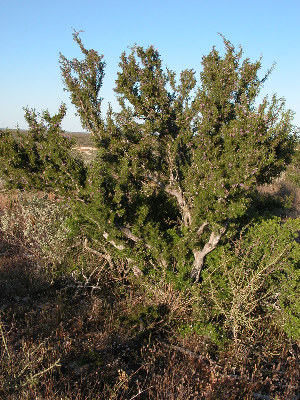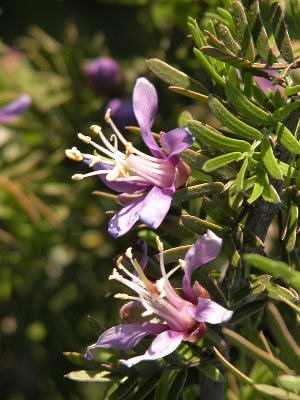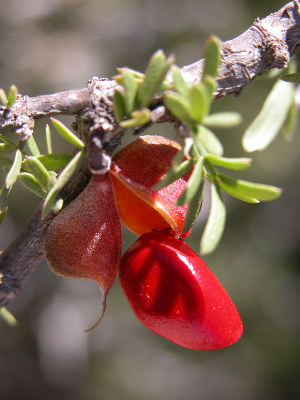Guayacán
Guaiacum angustifolium Engelm.
Zygophyllaceae (Caltrop Family)
Guayacán, in the same family as the creosote bush, is a shrub or small tree that can grow to a height of 15 feet or so. Its incredibly hard wood may have been used by native groups in the Lower Pecos canyonlands for toolmaking, although this has not been confirmed. The plant may also have been used for medicinal purposes.
Guayacán has pinnate, complex leaves with four to eight pairs of leaflets. The leaves appear to press against the stems or trunk, often giving guayacán the appearance of having its foliage pasted or pinned on by a passerby. The purple flowers are quite fragrant, 1/2 to 1 - inch wide, with five petals and long stamens . Thre fruit is a leathery capsule, beaked at the tip, bursting open to produce a shiny red seed (2-4 per fruit). The wood is very dense and sinks in water. The sapwood is a creamy-yellow color, and the heartwood is a dark purple-brown. It is so hard that the wood can be polished to a shine with steel wool.
Guayacán is widespread and very abundant in the Lower Pecos Canyonlands.
Archeological occurrence. Guayacán has not been identified in archeological collections. The Lower Pecos collections, however, have not been studied extensively and the known utility and the widespread distribution of the plant suggest that it will be identified in some of the wooden implements from the dry rockshelters.
Uses. Please note that the common name for guayacán is soaptree, and that its primary use in northern Mexico is as a detergent. This means that the plant is contains high concentrations of saponins, and saponins destroy animal cells. When a person ingests plant tissues or decoctions with saponins, at the least saponins act as a very strong laxative, and often as a purgative, or worse. So do not attempt to try using these plants for medicinal purposes. Practitioners of folk medicine had (and have) a vast, unwritten knowledge of their subject that is not readily available to outsiders.
In Mexico, under the direction of 19th century healers, guayacán was used as a medicine. The flowers were steamed and inhaled to treat tuberculosis in Sonora. In his Quatro Libros de la Naturaleza, Jimenez noted that extract of the wood functioned as a purgative as well as a diuretic, depending on the dosage. As such, it was considered a good medicine for the kidneys and stomach (Martinez 1969). Other uses for guayacán were as a soap or detergent, and as a wood for fashioning implements and fence posts (Standley 1922).
References:
Martinez, Maximino
1969 Las Plantas Medicinales de Mexico. Quinta Edicion. Ediciones Botas, Mexico City.
Standley, Paul Carpenter
1922 Trees and Shrubs of Mexico Part III. Contributions to the United States National Herbarium 23, Washington, D.C.
![]()


